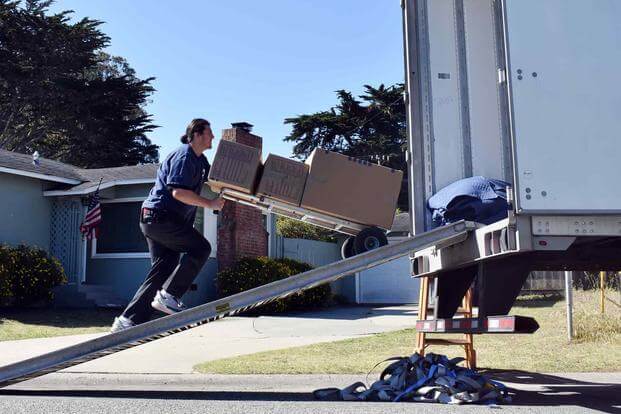
Service members and families at 14 stateside U.S. military installations will be the first to relocate under the Defense Department’s new privatized process, U.S. Transportation Command announced Tuesday.
In the beginning, only moves picked up and delivered within about 50 miles of the same base will be carried out by HomeSafe Alliance, the entity formed by existing logistics firms that won the military’s Global Household Goods Contract and is set to take over management of household goods shipments.
So far, 13 of the first 14 installations where HomeSafe Alliance will begin to oversee shipments can now “issue task orders,” according to the release. Coast Guard Base Portsmouth, Virginia, will be the 14th, with the ability to issue task orders anticipated “before the beginning of May.”
Read Next: New Cold-Assignment Incentive Pay Coming for Airmen and Guardians at 7 Bases
HomeSafe Alliance’s takeover will start slowly, Transportation Command officials told reporters in February. Installations where the first moves will take place are located primarily within five geographic areas: Norfolk, Virginia; Jacksonville, North Carolina; Seattle/Tacoma, Washington; Marine Corps Base Camp Pendleton, California; and San Diego, California. The 14 installations are:
- Naval Station Norfolk, Virginia
- Marine Corps Base Camp Lejeune, North Carolina
- Marine Corps Air Station Cherry Point, North Carolina
- Naval Base Kitsap, Washington
- Naval Station Everett, Washington
- Naval Air Station Whidbey Island, Washington
- Coast Guard Base Seattle, Washington
- Joint Base Lewis-McChord, Washington
- Marine Corps Base Camp Pendleton, California
- Marine Corps Recruit Depot San Diego, California
- Naval Base San Diego, California
- Naval Base Ventura County-Port Hueneme, California
- Naval Air Station Lemoore, California
- Coast Guard Base Portsmouth, Virginia
Service members moving within 50 miles of their current installation likely won’t be doing so on permanent change of station, or PCS, orders but instead moving into or out of base housing, retiring to live in the local community, or moving under other special circumstances.
To identify the local moves, all service members requesting a new shipment, no matter where they’re located, will be directed to fill out a questionnaire, according to the release. Those selected will then be directed to the DoD’s new online tool MilMove to upload their orders and other information and request a pick-up date; and then to HomeSafe Alliance’s HomeSafe Connect app to manage and track their shipment.
Tech challenges in the development of the two digital applications had delayed the rollout of the all-new process and private management, which the Pentagon hopes will improve the often-frustrating military relocation process.
Once the new process is working and “moves have been executed successfully according to contract requirements,” the DoD will then “gradually increase volume and add interstate moves for these initial locations over the coming months,” according to the release.
After peak moving season ends in August, more locations will be added, with 4% of domestic shipments projected to be under the new contract in September; 10% in October and November; 20% in December; and all by the end of 2025. International shipments won’t start before September 2025.
“All plans for GHC phase-in are subject to change,” and Transportation Command “will share updated timelines and locations as they become available,” the command said.






